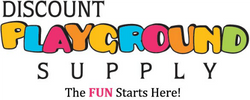The ground where your playground sits needs to be safe for children as they run, play, and (inevitably) fall. The best surfacing material cushions the feet and prevents injuries from trips and falls. Two common surfacing options include pea gravel and rubber surfacing. Read on as we discuss the differences between pea gravel and rubber surfacing and how to choose the right one for your playground.
What Is Pea Gravel?
Pea gravel gets its name from the fact that the particles are about the size of peas. These small rocks come from eroded river rock. After years of erosion, the edges are smooth and round, not sharp. Pea gravel comes in light shades of tan or gray that fit any outdoor setting.
The Pros and Cons of Pea Gravel as a Playground Surface
Pea gravel has some benefits, but it may not be the right solution for your playground surface needs. Let’s look at the pros and cons of pea gravel as a surface material:
On the plus side, pea gravel lasts for several years. However, this material is hard and does not offer cushioning when someone falls. Also, pea gravel is not ADA (Americans with Disabilities Act) compliant since a wheelchair user cannot maneuver safely on it.
What Is Rubber Surfacing?
Rubber surfacing is made of rubber and creates a cushiony ground for playscapes. It’s eco-friendly since it comes from recycled materials and has the benefit of reducing noise because of its soft texture.
Rubber surfacing comes in two forms: rubber mulch or pour-in-place (PIP) rubber surfacing. Both are common on playgrounds.
The Pros and Cons of Rubber Surfacing
Rubber surfacing has many pros. We’ll begin with the benefits and downsides of rubber mulch, then explore PIP rubber surfacing.
Rubber Mulch
Rubber mulch comes from recycled tires, which makes it environmentally friendly. Here are a few positives and negatives about this play surface:
Pros
- Eco-friendly.
- Doesn’t break down easily.
- Seldom needs a new layer.
- Easy maintenance.
- Soft surface for children.
Cons
- Can be expensive to install.
- Retains heat in the summer.
Rubber Surfacing
PIP Rubber surfacing is made by mixing rubber granules with a polyurethane resin binder. Many playgrounds benefit from this surfacing. The following are some of the pros and cons of PIP rubber surface materials.
Pros
- Lasts many years.
- Soft and shock absorbent.
- ADA compliant: smooth and wheelchair friendly.
- Prevents dangerous things from being buried in the playground surface.
- Different color choices.
- Spot repairs are affordable.
- Easy to clean.
- Looks welcoming.
Cons
- Colder climates may need a fresh surface more often due to the rubber becoming hard.
When comparing pea gravel and rubber surfacing materials, we hope you can see that rubber is the better choice for playgrounds. Now, all you have to do is choose between rubber mulch or PIP rubber surfacing! At Discount Playground Supply, we carry pour-in-place rubber surfacing kits to help you with your playground surface needs. Contact us with all your play area concerns, and we’ll point you in the right direction.

